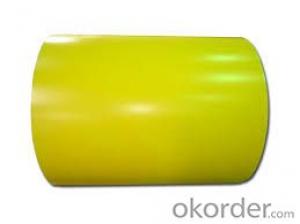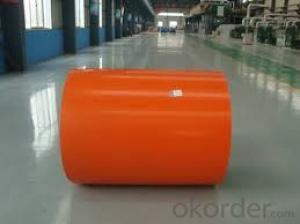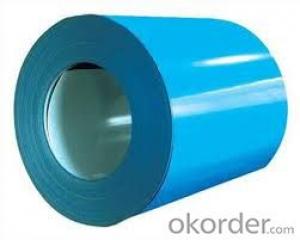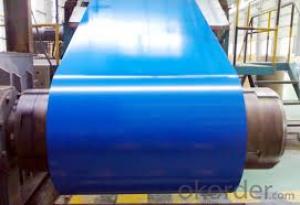Prepainted galvanized Corrugated plate / sheet in China
- Loading Port:
- Tianjin
- Payment Terms:
- TT OR LC
- Min Order Qty:
- 100 m.t.
- Supply Capability:
- 500000 m.t./month
OKorder Service Pledge
OKorder Financial Service
You Might Also Like
Brief Introduction of Prepainted Galvanized Steel:
Prepainted Galvanized Steel usually refers to have substrate processed with surface processed and coated then(roller coated )or bonded organic thin film and baked, and it is able to be processed to final production .
Prepainted Galvanized Steel qualified with excellent decorative, formability, corrosion resistance, coating adhesion ,can keep for a long time as well as maintain fresh color .For color coated steel sheet can obtain good economic benefit by steel belt wood ,efficient in construction and save energy ,prevent pollution etc. Which is an ideal material; for manufacturing board.
Description of Prepainted Galvanized Steel:
1.material : galvanized steel sheet / prepainted galvanized sheet
2.sheet thickness : normal use 0.3-0.6mm
3.length: any length, according to the transportation, generally less than 12m
4.color: standard color: red, blue, white, grey; special color: according to RAL color
Specification of Prepainted Galvanized Steel:
prepainted corrugated steel plate | |
material | galvanized steel sheet |
prepainted galvanized sheet | |
model No. | types of roof sheets |
sheet thickness | normal use 0.3-0.6mm |
length | any length, according to the transportation, generally less than 12m |
color | standard color:red, blue, white, grey |
special color: according to RAL color | |
characteristic | 1:weather proof |
2:heating insulation | |
3:fireproof | |
4:anti-rust | |
5:sound insulation | |
6:long life span: more than 15 years | |
advantages | 1.low foundation cost |
2.easy construction | |
3.time saving | |
4.labor saving | |
application field | 1:construction:prefabricated house, steel house, mobile house, modular house, villa, bungalow design, portable house/carbin, ready made house, kiosk booths, steel building... |
2:container manufacturing | |
3:household appliances and furniture | |
4:vehicle and vessel manufacturing | |
5:others,like machinery structual parts, manufacturing shells of motors and so on | |
packing | plastic film, pallet or as your request |
Applications of Prepainted Galvanized Steel
It can be widely used in transportation, light industry, civil usage and farming. It is also the perfect building material in construction for making steel roofing, insulation panel, corrugate sheet, facade wall, shutters, T-bar and home appliance.
Packaging & Delivery of Prepainted Galvanized Steel
The packing of coils consists of anti-damp paper, PVC film, hardboard paper, steel box, strapped with steel strips, fitted with locks and edge protectors and guarantees the optimal condition of the delivered goods. Each coil can be additionally fitted with wooden/steel skids(eye to the side) or wooden pallets(eye to the sky).
Images of Prepainted Galvanized Steel:
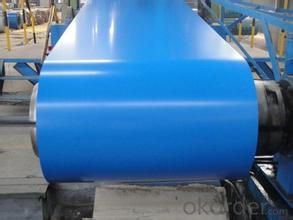
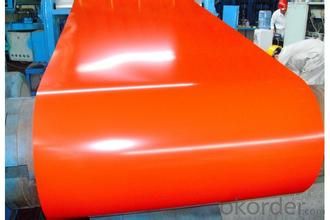
- Q:Are steel sheets suitable for HVAC ductwork?
- Yes, steel sheets are suitable for HVAC ductwork. Steel is a durable and strong material that can withstand the pressure and temperature changes associated with HVAC systems. It is also resistant to corrosion and leakage, making it an ideal choice for ductwork applications. Additionally, steel sheets can be easily fabricated and installed, ensuring a reliable and efficient HVAC system.
- Q:What is the thickness of the paint board?
- Paint plate generally in accordance with the "block" as the unit sales, not only as a wall decoration, doors, tables and chairs can do the shelves, cabinets bearing surface, the thickness of 1-2 cm in length, 50 - 120, 30 cm wide case is 55*30*1.5cm
- Q:How do steel sheets handle water resistance?
- Due to their inherent properties and protective coatings, steel sheets generally possess excellent water resistance. Steel, being a non-porous material, does not readily allow water to penetrate. The smooth surface of steel sheets effectively prevents water seepage. Moreover, steel sheets are commonly coated with protective layers like galvanized zinc or paint, further enhancing their water resistance. Galvanized steel sheets are furnished with a zinc layer that acts as a moisture barrier and safeguards against corrosion. Zinc displays high resistance to water, and even if the coating sustains scratches, the sacrificial zinc layer shields the underlying steel from rusting. Consequently, galvanized steel sheets exhibit remarkable durability and water resistance, even under extreme conditions. Painted steel sheets represent another prevalent alternative. The paint serves as a safeguarding layer that obstructs direct contact between water and the steel surface. By forming a barrier, the paint effectively prevents moisture from infiltrating the steel and causing corrosion. Nevertheless, it is crucial to acknowledge that the quality and thickness of the paint coating significantly influence the water resistance of painted steel sheets. To summarize, steel sheets possess commendable water resistance due to their non-porous nature and the presence of protective coatings. Whether it is galvanized steel sheets with a zinc coating or painted steel sheets with a protective layer of paint, both choices offer reliable water resistance and prove suitable for diverse applications where exposure to water is a concern.
- Q:How do steel sheets perform in terms of earthquake resistance?
- Steel sheets are highly effective in enhancing earthquake resistance due to their high strength and flexibility. The flexibility of steel enables it to absorb and dissipate seismic energy, reducing the impact on the structure. Additionally, steel sheets can be designed and fabricated to withstand specific seismic loads, making them a preferred choice for earthquake-resistant construction.
- Q:How do steel sheets perform in terms of fatigue resistance?
- Steel sheets are known for their outstanding fatigue resistance. Their high strength and durability allow them to endure repeated cyclic loading without experiencing significant damage or failure. This fatigue resistance is due to the material's capacity to absorb and distribute stress, effectively preventing the accumulation of cracks or fractures. Moreover, the fatigue resistance of steel sheets can be further enhanced through various heat treatment methods, like quenching and tempering, which improve their fatigue resistance properties. As a result, steel sheets are frequently chosen for applications where fatigue resistance is crucial, particularly in the automotive and aerospace industries, as they can endure prolonged and repeated loading without compromising their structural integrity.
- Q:What does "Z" mean to the performance of steel?
- Z to the plate, also known as "Z" to steel, also known as "lamellar steel tearing resistant steel", that is usually referred to as Z performance.The use of welded connections in steel structure, when the sheet thickness of not less than 40 mm and bear along the thickness direction of the tension, to avoid lamellar tearing when welding, the lamellar tearing of steel (commonly referred to as the "Z to steel"). There is a lamellar tearing problem in thick plates, so Z performance test is necessary.
- Q:What is the difference between a hot rolled and cold rolled galvanized steel sheet?
- The manufacturing process and resulting properties of a galvanized steel sheet differ between hot rolled and cold rolled. Hot rolled sheets are created by heating a large steel slab or billet above its recrystallization temperature, usually around 1700°F (926°C). This high temperature allows for easy shaping and forming of the steel into the desired thickness and dimensions. It also refines the grain structure and produces improved mechanical properties and a more uniform distribution of alloying elements. On the other hand, cold rolled sheets are manufactured at room temperature by passing the hot rolled sheet through rollers that compress and shape the material. This reduces the thickness of the sheet, increases its tensile strength, and improves its surface finish. Cold rolling also allows for tighter tolerances and more precise dimensions, making it suitable for applications that require high precision and consistency. In terms of properties, hot rolled sheets have a rougher surface finish due to the high temperature processing. However, they are generally more ductile and easier to form or bend compared to cold rolled sheets. Hot rolled sheets also have a slightly thicker oxide layer on the surface, providing additional corrosion resistance. On the other hand, cold rolled sheets have a smoother and more polished surface finish. They are typically thinner and have a higher strength-to-weight ratio compared to hot rolled sheets. The cold rolling process also results in a more homogeneous microstructure, improving the overall mechanical properties such as hardness and toughness. Ultimately, the choice between hot rolled and cold rolled galvanized steel sheets depends on the specific requirements of the application. Hot rolled sheets are often preferred for applications that require easy formability and a rougher surface finish, while cold rolled sheets are favored for their higher strength, tighter tolerances, and smoother surface finish.
- Q:What is the average lead time for manufacturing steel sheets?
- The average lead time for manufacturing steel sheets can vary depending on various factors such as the size and complexity of the order, the manufacturing process employed, and the current demand and capacity of the steel sheet production facility. However, in general, the average lead time for manufacturing steel sheets can range from a few weeks to a few months. If the order is relatively small and standard in size, the lead time may be shorter, typically ranging from 2 to 6 weeks. This time frame allows for the procurement of raw materials, processing, and quality control procedures to ensure the final product meets the required specifications. On the other hand, if the order is larger or involves more complex specifications, the lead time may be longer. This is because additional time may be required for customizing the steel sheets according to specific dimensions, finishes, or treatments. In such cases, the lead time can extend to several months. It is important to note that lead times can also be influenced by external factors such as supply chain disruptions, unforeseen delays in raw material procurement, or fluctuations in demand. Therefore, it is always advisable to consult with the steel sheet manufacturer or supplier for an accurate estimate of the lead time based on the specific requirements of the order.
- Q:Are steel sheets suitable for electrical applications?
- Yes, steel sheets can be suitable for electrical applications. They have good electrical conductivity and can be used for applications such as electrical enclosures, panels, and grounding components. However, it is important to consider factors like insulation and corrosion resistance when using steel sheets in electrical applications.
- Q:How do steel sheets handle thermal expansion?
- Steel sheets handle thermal expansion by expanding in size when heated and contracting when cooled. This expansion and contraction is accommodated through the flexibility and ductility of steel, allowing it to withstand and adjust to changes in temperature without significant damage or deformation.
1. Manufacturer Overview |
|
|---|---|
| Location | |
| Year Established | |
| Annual Output Value | |
| Main Markets | |
| Company Certifications | |
2. Manufacturer Certificates |
|
|---|---|
| a) Certification Name | |
| Range | |
| Reference | |
| Validity Period | |
3. Manufacturer Capability |
|
|---|---|
| a)Trade Capacity | |
| Nearest Port | |
| Export Percentage | |
| No.of Employees in Trade Department | |
| Language Spoken: | |
| b)Factory Information | |
| Factory Size: | |
| No. of Production Lines | |
| Contract Manufacturing | |
| Product Price Range | |
Send your message to us
Prepainted galvanized Corrugated plate / sheet in China
- Loading Port:
- Tianjin
- Payment Terms:
- TT OR LC
- Min Order Qty:
- 100 m.t.
- Supply Capability:
- 500000 m.t./month
OKorder Service Pledge
OKorder Financial Service
Similar products
New products
Hot products
Hot Searches
Related keywords
